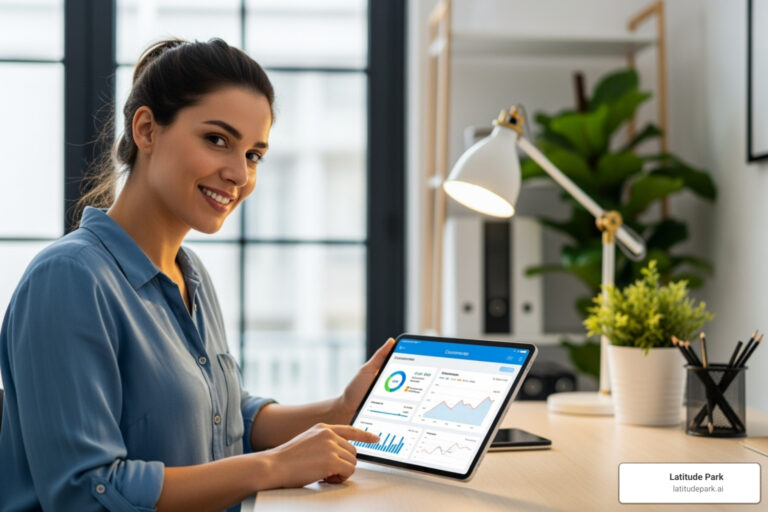What is a Google Business Profile and Why It’s Your Most Powerful Local SEO Tool
Optimizing Google My Business is the fastest way to boost your local visibility and attract more customers through Google Search and Maps.
Quick Optimization Checklist:
- Complete every profile section – Name, address, phone, hours, description, categories
- Add high-quality photos – Interior, exterior, team, and product images (businesses with photos get 42% more direction requests)
- Collect and respond to reviews – 62% of customers will write reviews if asked
- Post regular updates – Weekly posts signal an active business to Google
- Choose specific categories – Use your most relevant primary category plus 3-5 secondary ones
- Enable messaging – Allow customers to contact you directly from your profile
Your Google Business Profile appears in 84% of local searches, making it more visible than your website in many cases. When optimized correctly, it becomes a powerful customer acquisition tool that works 24/7 to showcase your business, build trust, and drive actions like calls, visits, and website clicks.
Unlike traditional SEO that can take months to show results, a well-optimized profile can start generating more leads within weeks. For franchise businesses, this scalability across multiple locations makes it an essential component of any digital marketing strategy.
I’m Rusty Rich, President and founder of Latitude Park, a digital advertising agency helping businesses maximize their online presence since 2009. Through years of optimizing Google My Business profiles for small businesses and franchises, I’ve seen how proper optimization can transform a business’s local visibility and customer acquisition.

Understanding Google’s Local Ranking Algorithm
Google’s local ranking algorithm connects customers with the perfect local business for their needs. When someone searches for “pizza near me,” Google evaluates thousands of businesses to serve up the most helpful results based on three core factors.
Relevance is how well your business matches a search. When optimizing Google My Business, completeness is key. The more detailed information you provide—from business categories and description to products and services—the better Google understands what you offer and can confidently recommend you.
Distance is more than just miles. If a searcher doesn’t specify a location, Google uses what it knows about their location to calculate distance. This is why complete and accurate location information is crucial.
Prominence measures how well-known and trusted your business is, both online and offline. Google looks at information from across the web—links, articles, directory listings, and especially customer reviews. Reviews are a major influence on consumer buying decisions and carry serious weight in the algorithm. Your website’s overall search performance also feeds into this score.
You cannot pay Google for better local rankings. The algorithm is designed to provide objective results based on these three factors, leveling the playing field. Smart optimization often beats big advertising budgets.
Google constantly refines its algorithm. A 2021 “diversity update” made it harder for one business to dominate local search results, emphasizing why strategic optimization matters more than ever.
Our approach to local SEO considers all these factors, which we detail in our guide on optimizing your website for local search results. For the most current guidance, Google’s own tips to improve your local ranking provide valuable insights.
The Core Pillars of Optimizing Google Business Profile
Your Google Business Profile is your digital storefront, capturing the attention of potential customers searching on Google and Maps. Optimizing Google My Business is about creating a compelling digital experience that builds trust and motivates people to choose you.

This is critical because 84% of Business Profile views come from findy searches—searches where people are looking for a solution, not your specific business. A well-optimized profile can capture customers who didn’t know you existed minutes ago. When we work on optimizing Google My Business profiles, we turn incomplete listings into customer-converting powerhouses, leading to improved rankings, higher engagement, and more customers.
Our “8 Ways SEO Marketing Services Can Help Your Business” approach centers on six core pillars.
Step 1: Claim, Verify, and Complete Your Foundational Information
Business verification is your first step; it’s Google’s way of confirming you’re the legitimate owner. Our “How to Put Your Business on Google: A Step-by-Step Guide” walks you through this process.
NAP consistency is critical. Your Name, Address, and Phone number must be identical everywhere online. Even small differences like “St.” versus “Street” can confuse Google and hurt your rankings.
Business hours must be accurate, as 64% of customers use profiles to find contact info. Inaccurate hours frustrate customers. Always update for holiday hours and special events.
For service area businesses, defining your service areas helps Google understand where you operate. You can hide your address and show service areas instead, which is ideal for businesses that visit customers.
Step 2: Write a Compelling ‘From the Business’ Description
You have 750 characters, but the first 250 are most important as they often appear in search results. This is your elevator pitch.
Keyword inclusion should feel natural. Instead of stuffing, write something like, “Family-owned Italian restaurant serving authentic wood-fired pizza and fresh pasta since 1987.” This includes keywords while telling customers what makes you special.
Highlight your unique value proposition. What do you do differently? Are you the only 24-hour clinic, or do you use all-organic ingredients? This is where you state it.
Remember the technical limits: no HTML and no links. Keep it plain text and repurpose content from your website’s About Us section if needed.
Step 3: Choose Hyper-Specific Business Categories
Your primary category tells Google where to place you. Be as specific as possible—choose “Nail Salon,” not just “Salon.” This matters because 84% of views come from findy searches. When someone searches “Egyptian restaurant near me,” Google uses categories to find relevant profiles.
Secondary categories capture additional search opportunities. A “Pizza Restaurant” might also offer “Pizza Delivery Service.” You can add up to nine additional categories, but only use ones that accurately represent your offerings.
Choosing the right categories also open ups category-specific features, like menu options for restaurants or booking buttons for salons, making it easier for customers to do business with you.
Step 4: Showcase Your Offerings with Products and Services
Your product catalog and service menu act as a 24/7 digital brochure. Customers can browse what you offer, check prices, and get descriptions anytime.
Pricing transparency builds trust and sets expectations. Listing a price range like “Dinner Entrees: $18-$32” helps filter customers.
Use calls-to-action in your service descriptions. Instead of just “Website Design,” try “Website Design – Contact us for a free consultation.” This provides direct customer information on how to proceed.
Each product or service entry gives Google more context about what you do, improving your relevance for specific searches like “Snow Removal” in the off-season for a landscaping company.
Step 5: Attract Customers with High-Quality Photos and Videos
Businesses with photos get 42% more direction requests and 35% more website clicks. Businesses with over 100 photos see even more dramatic increases in calls, direction requests, and website clicks.

While photo quantity impacts visibility, quality is equally important. Use exterior photos for recognition, interior photos to showcase atmosphere, and team photos to build a human connection. Follow Google’s photo guidelines and show your business in action. Geotagging photos can help with Google Image Search visibility.
360º photos offer an immersive look, while video content up to 30 seconds can showcase your personality. Upload new photos regularly (at least weekly) to signal to Google that your profile is active.
Step 6: Build Trust and Rank Higher with Customer Reviews
Customer reviews are a key ranking factor and the top influence on buying decisions. An encouraging 62% of customers will write reviews if asked.
Your review generation strategy should make it easy. Create a direct review shortcut link and share it in emails or on receipts. Start with your most loyal customers.
Responding to reviews shows you value feedback. Thank positive reviewers and address negative reviews professionally, offering to resolve issues offline. Aim to respond within 24 hours.
Review quality matters as much as quantity. Detailed reviews that mention specific services give Google more context and provide more value to future customers than generic comments.
Advanced Strategies and Ongoing Maintenance
Optimizing Google My Business is an ongoing process that requires consistent attention. Your profile is a living extension of your business that needs regular nurturing to thrive. These regular updates signal to Google that your business is active and relevant, which can significantly boost your local ranking. This commitment is a cornerstone of our 7 Keys to Local Search Success.

Use Google Posts to Drive Engagement and Conversions
Google Posts are like mini-blog entries on your profile for sharing timely information. Use different post types: Updates for general news, Offers for promotions, Events for announcements, and Products to highlight specific items.
Post at least once a week to maintain activity. Every post should include a clear call-to-action—like “Learn More” or “Buy”—and link to a relevant page on your website to drive conversions. Always use high-quality images or videos. To save time, repurpose content from your other social media channels.
Proactively Manage the Questions & Answers Section
The Q&A section is a goldmine for demonstrating expertise, but since anyone can ask and answer, it requires active management. You can’t disable it, so take control proactively.
Set up alerts to be notified of new questions so you can respond quickly and correct misinformation. A smart tactic is to seed your own Q&A by posting frequently asked questions and providing your own official answers. This lets you control the narrative and incorporate keywords. Monitor the section regularly, upvote correct answers, and flag incorrect information for removal.
Enable Messaging for Direct Customer Communication
With 82% of smartphone shoppers using their device for local search, messaging is a valuable feature that provides instant gratification. It creates a low-friction path for customers to ask questions or book appointments.
Success with messaging depends on response time. Google may display your average, so be prepared to respond quickly. If you can’t, use automated responses or disable the feature to avoid frustrating potential customers.
Best Practices for Multi-Location and Franchise Businesses
Managing multiple GBP locations requires a strategic approach. Our Franchise GMB Marketing services are designed to handle these complexities.
Centralized management is essential. While Google’s bulk tools help, each location still needs individual attention. NAP consistency is crucial for every location. The key is balancing consistent branding with localized content. Each profile needs local photos, posts, and promotions relevant to its community.
Strategic categorization is also more nuanced. A law firm might use a general category for its main office and more specific ones for branches. Each location needs a unique local phone number and address, and Google Posts should be customized to prevent confusion and build stronger community ties.
Track Performance with GBP Insights and UTM Codes
Tracking and analysis are vital for understanding the impact of your GBP optimization.
Google Business Profile Insights offers data on how customers find you (direct vs. findy searches), where they view your profile (Search vs. Maps), and what actions they take. For deeper analysis, use UTM codes on all GBP links (website, posts, products). This lets you track clicks with UTMs and Google Analytics to measure traffic and conversions from your profile. Call tracking with a unique number also helps you accurately measure calls and calculate ROI.
Common GBP Mistakes to Avoid
- Keyword stuffing your business name is against Google’s guidelines and can lead to suspension. Stick to your legal business name.
- Address accuracy is non-negotiable. Google requires a physical address accessible to customers. Using P.O. boxes or unstaffed virtual offices can lead to suspension.
- Neglecting customer engagement by ignoring reviews and Q&A suggests an inactive business and allows misinformation to spread.
- Inaccurate business hours frustrate customers and lead to negative reviews. Keep hours current, including holidays.
- Overly broad categories limit your visibility. Be as specific as possible to appear in targeted searches.
Frequently Asked Questions about Optimizing Google Business Profile
When it comes to optimizing Google My Business, business owners often ask the same questions. After helping hundreds of businesses, I’ve learned that addressing these key concerns can make the difference between a profile that just exists and one that drives results.
Here are the three most common questions I get:
How long does it take to see results from GBP optimization?
Results vary by industry and the initial state of your profile, but you can typically expect to see improvements in visibility and engagement within 30 to 90 days of implementing a thorough optimization strategy.
Initial changes, like more profile views, can appear in weeks. Phone calls and direction requests often start increasing around the 30-day mark, especially with active review collection and posting. Consistent maintenance is crucial. GBP isn’t a “set it and forget it” tool. Long-term success requires treating it as a core part of your marketing, with weekly posts, photo uploads, and prompt review responses.
Can I rank in a city where I don’t have a physical address?
This is extremely difficult. Google’s local algorithm heavily prioritizes proximity. It wants to show users businesses that are actually close to them.
Service Area Businesses (SABs) can define a service area, but ranking strength is always strongest near the verification address. Your ranking power diminishes with distance. To expand into new markets, the most effective strategy is to establish a legitimate physical presence there to gain the proximity factor Google rewards.
How often should I post on my Google Business Profile?
I advise clients to treat their Google Business Profile like a social media channel. This mindset changes the approach to ongoing maintenance.
Aim to publish a Google Post at least once a week. This signals activity to Google, which can boost your ranking, and keeps customers updated with fresh content and offers. Weekly posting is manageable if you repurpose content from other social media. The businesses I work with that post consistently outperform their competitors in engagement. It’s a simple strategy that compounds over time.
Conclusion: Turn Your Profile into a Customer Magnet
Your Google Business Profile is your digital storefront that never closes. Optimizing Google My Business has evolved from a nice-to-have into a must-have for any business serious about local success.
When 84% of profile views come from people searching for businesses like yours, a well-optimized profile becomes your secret weapon for capturing new customers. The strategies we’ve covered—from completing every profile section and choosing hyper-specific categories to managing reviews proactively and posting regular updates—work together to create a profile that converts browsers into buyers.
Local search dominance requires continuous improvement. Your competitors aren’t standing still. Regular photo uploads, consistent Google Posts, prompt review responses, and ongoing performance tracking are what separate the businesses that thrive from those that merely survive. The impact is measurable: when customers can easily find information, see photos, read reviews, and message you, they are far more likely to choose you.
For franchise owners and multi-location businesses, the complexity multiplies, but so does the opportunity. Managing numerous profiles while maintaining consistency and local relevance requires expertise.
That’s where we come in. At Latitude Park, we understand that busy business owners shouldn’t have to become Google Business Profile experts. Our team has been helping businesses master their local presence since 2009.
Ready to transform your profile into a customer magnet? Find out how local SEO services can dramatically benefit your business and take the next step with our expert Google Business Profile Optimization services. Let’s open up your full local search potential together.









